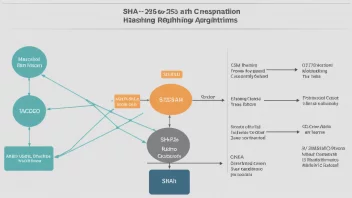Introduction
In this article, you will learn about cryptographic hashing algorithms, their importance in ensuring data integrity, applications in blockchain technology, and effective methods for password storage. You will also gain insights into how these algorithms work and their practical applications in real-world scenarios.
Step 1: What is a Cryptographic Hashing Algorithm?
A cryptographic hashing algorithm is a mathematical function that transforms input data (or 'message') into a fixed-size string of characters, which is typically a sequence of numbers and letters. This process helps ensure that any change in the input data will produce a significantly different hash output.
- Characteristics of Hash Functions:
- Deterministic: The same input will always produce the same hash.
- Fast computation: Hash functions are designed to be computed quickly.
- Pre-image resistance: It should be infeasible to reverse-engineer the original input from its hash output.
- Collision resistance: It should be difficult to find two different inputs that produce the same hash.
Step 2: Applications of Cryptographic Hashing
Cryptographic hashing algorithms have several critical applications:
- Data Integrity: Used to verify the integrity of data; if the hash of the data matches the original hash, the data is intact.
- Blockchain Technology: Each block in a blockchain contains the hash of the previous block, ensuring the integrity of the entire chain and making tampering evident.
- Password Storage: Instead of storing passwords in plain text, systems store hashes of passwords, making it difficult for attackers to retrieve the original passwords even if they gain access to the database.
Step 3: Popular Cryptographic Hashing Algorithms
Some of the most popular cryptographic hashing algorithms include:
- SHA-256: Part of the SHA-2 family, widely used in Bitcoin and other cryptocurrencies.
- SHA-3: The latest member of the Secure Hash Algorithm family, featuring a different design than SHA-2.
- MD5: An older algorithm that is no longer considered secure for cryptographic purposes due to vulnerabilities.
- Bcrypt: A password hashing function designed to be slow and resistant to brute-force attacks.
Step 4: Implementing Hashing in Password Storage
To securely store passwords using hashing, follow these steps:
- Choose a Hashing Algorithm: Use a strong algorithm like Bcrypt or Argon2 designed for password storage.
- Add Salt: Generate a unique random value (salt) for each password before hashing it. This adds a layer of security by preventing attackers from using precomputed hash tables (rainbow tables).
- Hash the Password: Combine the password with the salt and hash the result using your chosen algorithm.
- Store the Hash and Salt: Save both the hash and the salt in your database. Ensure that the salt is stored in plain text alongside the hash.
function hashPassword(password) {
const salt = generateRandomSalt();
const hash = bcrypt.hashSync(password + salt, 10);
return { hash, salt };
}Step 5: Verifying Passwords
When a user attempts to log in, follow these steps to verify their password:
- Retrieve the Stored Hash and Salt: Pull the stored hash and salt from your database.
- Hash the Input Password: Combine the input password with the stored salt and hash it.
- Compare Hashes: If the newly computed hash matches the stored hash, the password is correct.
function verifyPassword(inputPassword, storedHash, storedSalt) {
const hashToVerify = bcrypt.hashSync(inputPassword + storedSalt, 10);
return hashToVerify === storedHash;
}Step 6: Case Study: Hashing in Blockchain Technology
Consider a practical example in the context of blockchain technology. Bitcoin, the first cryptocurrency, uses the SHA-256 hashing algorithm. Each transaction is hashed, and these hashes are combined with the previous block's hash to form a new block in the blockchain. This ensures that if any data in a block is altered, the hash of that block will change, making it clear that tampering has occurred. This cryptographic integrity is foundational to the security of blockchain technology.
Summary
To summarize, cryptographic hashing algorithms play a crucial role in data integrity, password security, and blockchain technology. By understanding how to implement these algorithms effectively, you can enhance the security of your applications significantly.
In this article, we covered:
- The definition and characteristics of cryptographic hashing algorithms.
- The applications of hashing in data integrity, blockchain, and password storage.
- The implementation of secure password storage with hashing and salting.
- A case study of Bitcoin and its use of SHA-256.
As a final piece of advice, always keep up with the latest developments in cryptographic algorithms, as security practices and potential vulnerabilities are continually evolving.






